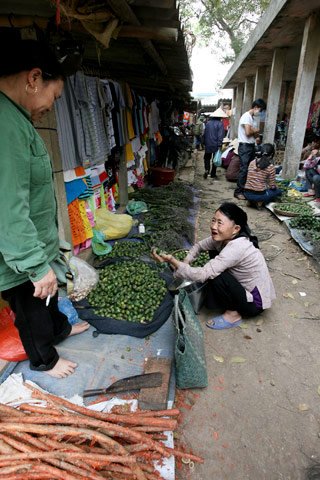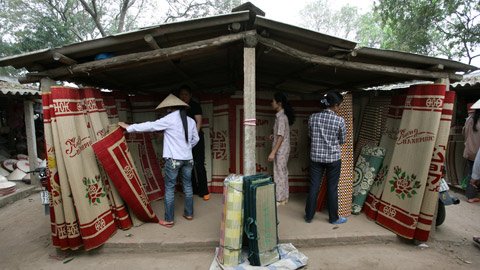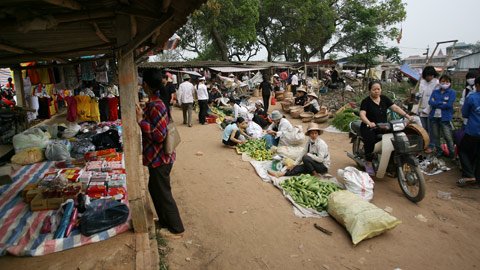Since 2002 the programme supporting the development and preservation of traditional Vietnammese villages has been funded by JICA. Many Japanese experts from the Japanese Cultural Derpartment, Nara National Institute of Cultural Assets and Chieu Hoa University have participated in restoring some of th works in the village, tec. Thay have also devised projects to assist farmers in developing tourism and improving their living standars throgh exploring the potentials and strengths the the village.
 |
| A path that leads to Duong Lam Ancient Village. |
With the guidance of Akio Inoue, we visited the ancient house owned by Nguyen Van Hung, a descendant of the the 12 th generation of the Nguyen Van family in Duong Lma. The winding road from Mong Phu Communal House leading to ancient house seems familiar to the Janpanese expert. In 2008, the over 360 year- old house wasevaluated and selected as the first work that needed to be restored and preserved. After nearly three months, the house not only remains intact but it has also become stronger.
 |
| Aiko learns about the ancient well in the Ancient Village of Duong Lam. |
Sitting in the airy space of the house, Akio talked and introduced us to Yoriko, an architect and cultural preservation specialist who works as a volunteer in the village.
She said: " Aiko`s job is to measure and check structures and wood materials and give out solutions, cuisine and custumes of the local people." Therefore, Akio is very close to the local people and she has learned many things. She has learned how to make Tuong( soya sauce), a specialty of the village and Che Lam ( puffed rice candy) She also knows how to drinks green tea, pick corn and dig potatoes. She talked alot about her life here. " I fell this place is very intimate and friendly as if i was living in my homeland."
 |
| Aiko learns how to make Tuong (soya sauce) from Phan Thi Son in the village. |
Akio graduated from the Cultural Heritage Preservation Specialist program at University College Lodon and she has worked in Duong Lam village since 2009. She said: " Many people have not yet recognized the value of the ancient village. They have primarily evaluated the architectural factors in terms of time while ignoring other important factors, such as custums, cuisine, and traditional custumes. It is necessary to evaluate all these areas in order to recognize the entire value of the ancient village. We need to hand down measures to sustainably restore and preserve the cultural and historical values and maintain anf improve the local`s living standards by promoting tourism activities".
Other the years, AKio has thoroghly researched, surveyed and participated in many spiritual cultural activities, She realizes that Duong Lam village has such basic values as naturem deverse scenary, good- natured anf open- mined people, long-standing traditions, custumes, ancient houses, the landscape of ancient houses, and a very argricultural production method. If there are not enough of these factors, the village will lose its typical features. For this reason, besides researching and preserving the works, shr and her colleagues have organized competions and field- trips for students to learn about these ancient village.
 |
| Aiko presents her research on Duong Lam at a scientific workshop. |
At present, she and Prof Tachibana in Showa University, Japan have helped to develop the cuisine service in the ancient houses and have made a map of the ancient village to assist tourists. She and other Japanese volunteers are also helping the villagers realize the value of the ancient village and to become aware of how to preserve the heritage and develop it as a unique tourism destination.
According to:
http://vietnam.vnanet.vn/vnp/en-US/30/20451/print/default.aspx






 Cách Đại lộ Thăng Long chỉ 3 km, chợ Nủa (Xã Bình Phú, huyện Thạch Thất, Hà Nội) vẫn đều đặn họp 5 ngày một phiên, điểm đặc biệt là phiên chợ này vẫn giữ được nhiều nét đặc sắc của các chợ phiên vùng đồng bằng Bắc Bộ xưa.
Cách Đại lộ Thăng Long chỉ 3 km, chợ Nủa (Xã Bình Phú, huyện Thạch Thất, Hà Nội) vẫn đều đặn họp 5 ngày một phiên, điểm đặc biệt là phiên chợ này vẫn giữ được nhiều nét đặc sắc của các chợ phiên vùng đồng bằng Bắc Bộ xưa.

